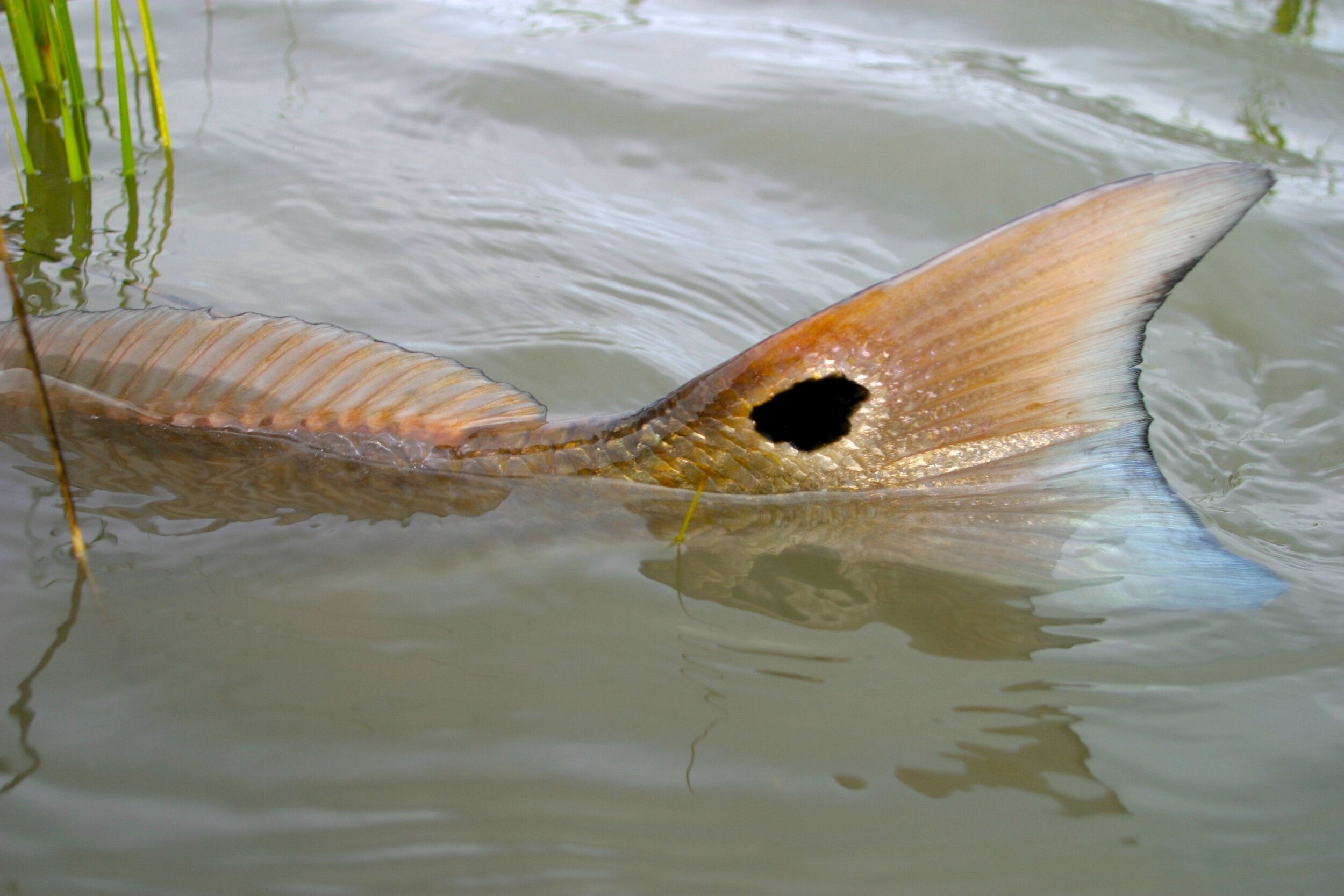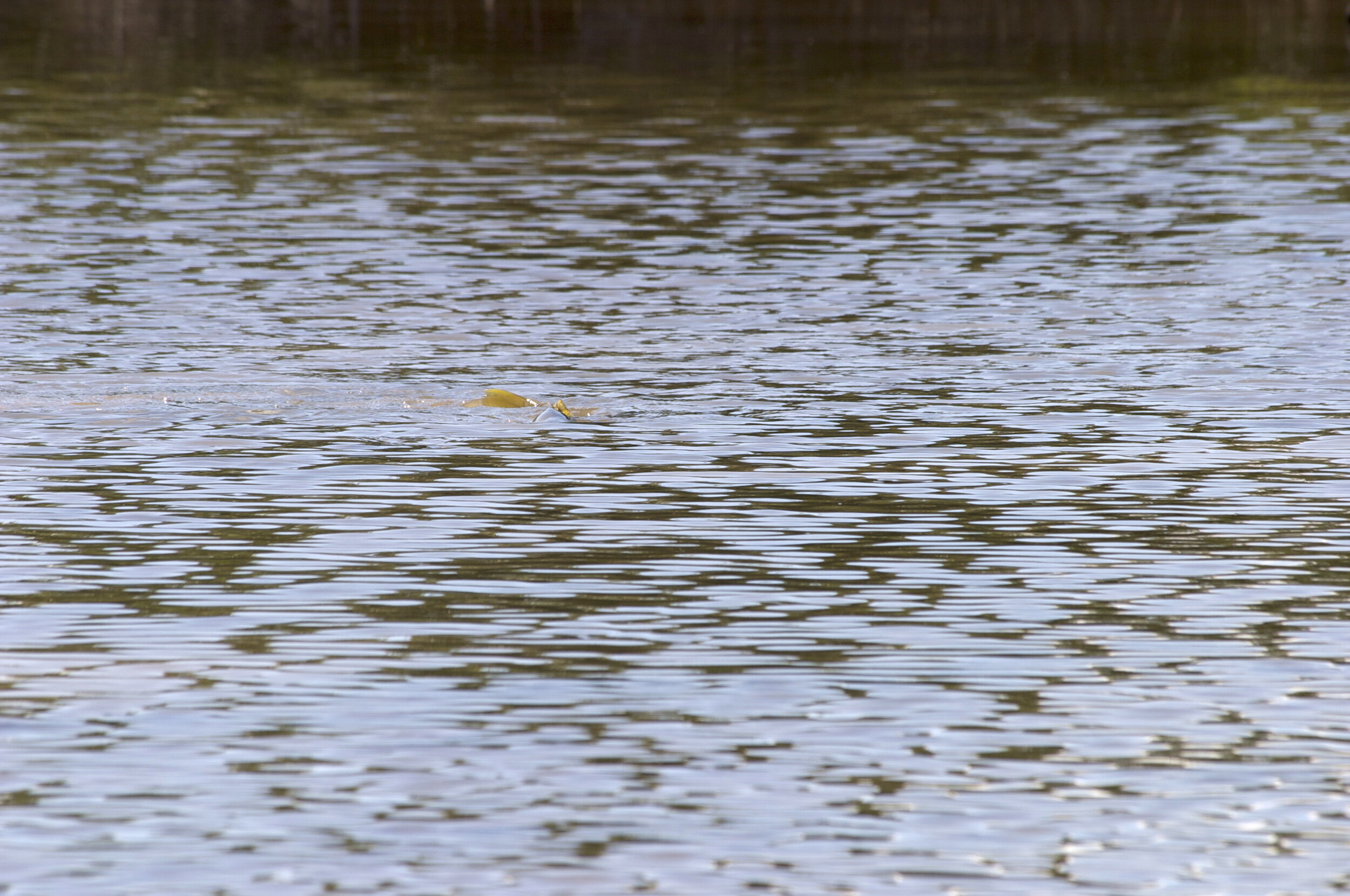Fishing Friday: The Secrets Of Sightfishing
By: John Kumiski
Don't look for goldfish in a bowl. This is what novices expect to see. Never happens! This was a caught fish being held by its head before it was released. Photo: John Kumiski
Rodney Smith and I were three miles off the beach of Patrick Air Force Base, idling slowly along, searching the waters of the Atlantic Ocean for cobia. There were no weeds, no flotsam, nothing to concentrate the fish, and after an hour I felt like we were searching for a needle in a haystack. But suddenly, a fish materialized not 40 feet away. Rodney made a perfect cast, and his rod bowed over as his reel sang the favorite song of the fisherman.
Equipment Essentials for Sight Fishing
Whether you prefer fishing in inches deep water, or fishing out of sight of land, few angling experiences compare with seeing a fish in the water, casting to it, manipulating the lure, and watching the fish take. In order to succeed consistently you must have two items of equipment. The first is a billed or broad brimmed hat. The brim keeps the direct light off of your sunglasses, making it much easier to see. The underside of the brim should be a dark color. The dark color reflects less light onto the face, reducing glare. You also need a pair of quality polarized sunglasses. The polarizing filters cut reflection from the water surface, making it easier to see into the water. The right glasses are extremely important.
An angler casts a fly to a tailing redfish while his buddy handles the canoe. He got the fish. Photo: John Kumiski
Inshore anglers usually prefer dark amber lenses, while gray is popular with the offshore crowd. The truly erudite angler carries both.
When I guided, fishermen would step into my boat with the finest tackle available, but wearing clip-on sunglasses over their prescription glasses. Clip-ons, while better than no sunglasses, are vastly inferior to prescription polaroids. Clip-ons give you four surfaces collecting dirt and causing glare and distortion instead of only two. They simply do not work as well. If you want to sightfish successfully, get and use good sunglasses.
Give Me a Sign
Sometimes a fish betrays its presence by causing disturbances on the water’s surface. Sunlight sometimes reflects off of the fins of fish at or above the water’s surface, and you can see the flash from a surprising distance.
Here a redfish pushes a wake as it pursues bait. When you see a wake, you may not be able to see what's making it, but you sure know something is there. Photo: John Kumiski
A fish cruising in shallow water pushes a wave up above it, known as a wake. To visualize what this looks like, think of a submarine moving through the water only five feet below the surface. It would make a disturbance on the surface, right?
Fish are smaller than submarines, but the principle is identical. Wakes are easily seen when it’s calm. They’re harder to see if it’s windy, but it can still be done. Moving waves have a pattern. They all move in the same direction. The heights are all in a certain range. Anything that breaks this pattern, that looks even slightly different, could be a fish.
The importance of looking into the water cannot be overstated. Most fish do not put up flags telling their enemies of their whereabouts. On the flats, fish enter shallow water looking for a meal, but they still try to hide as well as they can. Even in the deep water offshore, fish are frequently found near the top of the water column. If you want to see them you have to train yourself to look and to see.
Look into the water. This is easiest when there is little or no wind, the sun is high in the sky and at your back, there are no clouds. In shallow water the bottom should be light in color. That you need clean water should go without saying. Tilt your head back and forth to find the most effective angle for your sunglasses.
A pair of redfish tail on a beautiful afternoon. Easy to see! Photo: John Kumiski
Avoid staring at one spot. Keep your eyes scanning, looking for any break in the patterns you see. Scan back and forth, from close in to the boat to the limit of visibility and then back in close again. Your skill will improve as you practice.
What do you look for? Not a fish, but anything that might be a fish. Don’t expect to see a goldfish in a bowl. Most of the time you are looking for subtle clues of different kinds. Muds are easily seen and are usually caused by fish. Although the fish making muds may be mullet or stingrays, gamefish frequently follow both. Always investigate with a cast or two.
This is how a tailing fish usually presents itself- just the tip of the tail breaks the surface. Anything more than that is a bonus, a gift. Photo: John Kumiski
Sometimes you see the movement of the fish itself, or sometimes you see its shadow moving along the bottom as it swims.
Look for flashes. When fish turn or roll on their sides, their sides catch and reflect light. This lasts for only a brief moment, but is easy to see and is a dead giveaway to the presence of fish.
Look for differences in color. The light cream color of their pectoral fins is often the only visible clue to the presence of redfish when they cruise over a dark grass bottom. These fins are small, maybe the size of a quarter, not easy to see. Sometimes you’ll see what looks like a light-colored worm wiggling vertically in the water. This is a tailing redfish, but the water is too deep for the tail to break the surface. The “worm” is the blue tinge along the margin of the tail.
Watch flying birds. Birds move fish when flying over them. Photo: John Kumiski
Watch underneath any birds when they fly close to the water surface. As they pass over fish, the fish spook and jump. I’ve taken some fine fish after a wading bird in flight tipped me off to their presence.
Sometimes your ears can direct you to your quarry. Tailing fish splash. Quiet anglers can hear them. The distinct feeding pops of trout or snook are very easy to hear. When a school of jacks jumps on a school of mullet it can sound like someone is dropping bowling balls into the water!
Another thing to look for are motionless fishy-looking shapes. Sometimes fish lay up, not moving. Needless to say, they’re hard to see when they do this.
If you see something that looks like it might be a fish, cast to it! Many times I let my curiosity get the best of me and approach too closely. The fish lets me know that it is actually a fish and not a piece of wood by streaking off towards deeper water, leaving me feeling fishless and foolish.
in a shallow everglades pond, a snook swims with its back out of the water. They won't get any easier to see than this! Photo: John Kumiski
You usually can’t see the entire fish. Seatrout are one of the hardest of all fish to spot. Their dark backs blend in perfectly with grass. They often lie motionless over grassy bottoms, particularly around the edges of sandy areas. While they do this, they are almost impossible to see. Often the only clue you have to a trout’s presence is its tail, a little lighter in color than the background, with a darker band along the back edge. Check it out with a cast!
Never ignore anything. You’re a hunter and have to behave like one.
Maxx Kumiski is surrounded by tailing fish here. He got one! Photo: John Kumiski
For the majority of anglers, sightfishing is simply the most satisfying way to hook a fish. No matter what your favorite species is, watching them attack your bait adds so much to the angling experience that many people won’t fish any other way. Try using these secrets of sightfishing success, and see what you’ve been missing.
John Kumiski has been fishing, boating, and paddling Florida for 40 years. Get your signed copy of his book, Fishing Florida by Paddle, at https://www.spottedtail.com/fishing-florida-by-paddle/.
Have you done something interesting outdoors? Join Global Outdoors and write a review to tell everyone about it! We’re building the home for trusted reviews of outdoor experiences, outfitters, and guides. Help us out and you’ll be entered to win free trips!










